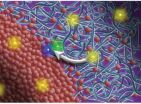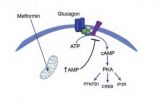(Press-News.org) PHILADELPHIA — Though churning smokestacks, cud-chewing cows and gasoline-burning vehicles are contributing constantly to greenhouse gas emissions, there are also many processes that do the reverse, pulling molecules like carbon dioxide out of the atmosphere. One of these is chemical weathering, which occurs when rock turns into soil. Carbon dioxide molecules and rain combine to dissolve rock, and the weathering products, including sediment, eventually make their way through waterways to the ocean where some become trapped on the ocean bottom and in coral reefs and seashells.
For years, geologists believed that mountains, due to their steep slopes and high rates of erosion, were large contributors to this "carbon draw down" effect. But a new study led by the University of Pennsylvania's Jane Willenbring suggests that mountains do not play a significant role in this activity, turning a geological paradigm on its head.
Willenbring, an assistant professor in the Department of Earth and Environmental Science, led the research, working with Alexandru Codilean of the GFZ German Research Center for Geosciences and Brandon McElroy of the University of Wyoming.
"High mountains have been the go-to field area for people interested in studying how much sediment goes into the ocean and how tectonics perturbs global climate," Willenbring said. "But what we found was that mountains contribute only a small amount of the total sediment produced on Earth."
This finding, published in the journal Geology, directly challenges previous studies, which suggested that small mountain rivers contributed most of the sediment to the world's oceans.
What these other scientists neglected to account for, according to Willenbring, was that even the steepest, most erosion- and weathering-prone slopes take up only a tiny fraction of the Earth's surface. So while these steep protrusions have very high rates of carbon absorption per unit area, they are far outstripped by the much more abundant expanses of gently sloping land.
"These small mountain streams are packing a big punch for their size," Willenbring said. "But even though they have a lot of erosion going on, the amount of the Earth covered by mountain ranges is too small to produce the amount of sediment that less steeply sloped areas produce."
The previous studies lacked access to a new investigative technique that was developed relatively recently. The method involves an examination of cosmogenic nuclides, which are rare forms of chemical elements produced only when supernovas explode, sending high-energy radiation to Earth and breaking up other atoms. Counting these chemical isotopes allows researchers to determine how long sediment has remained in a particular watershed over long time periods.
In contrast, techniques used previously, which involve physically measuring sediment flow in rivers and streams, only capture a snapshot of sediment erosion and deposition rates over a short time frame.
The researchers analyzed published data on cosmogenic nuclide concentrations from around the world to determine the levels of sediment flux over a time frame of thousands to hundreds of thousands of years. They also gathered topographical data to determine the slopes of the surrounding areas. They then extrapolated these rates of sediment deposition to the whole Earth's surface.
"What the cosmogenic nuclides tell us is that chemical weathering still happens in these low sloping areas," Willenbring said.
Other scientists had believed these gently rolling or flat areas, such as floodplains, to be "trappers" of sediment, but the research team's analysis demonstrated that, despite being areas of net deposition, they are in fact still drawing large amounts of carbon dioxide from the atmosphere.
Given these findings, geologists interested in understanding the contribution of erosion to climate fluctuations may want to spend less time on mountaintops and more time in big, lower-lying rivers like the Mississippi and the Amazon, Willenbring said.
"We're going to need to start studying 'boring' rivers if we're going to understand carbon and sediment cycling."
###
The National Science Foundation and GFZ Potsdam supported this study. END
Penn study shows mountains are only minor contributors to erosion and climate regulation
2013-01-07
ELSE PRESS RELEASES FROM THIS DATE:
A French nuclear exit?
2013-01-07
Los Angeles, CA (January 07, 2013). France has been held up, worldwide, as the forerunner in using nuclear fission to produce electricity. However, a third of the nation's nuclear reactors will need replacing in the next decade, and public opinion has shifted toward reducing reliance on nuclear power. In a special issue of the Bulletin of the Atomic Scientists, published by SAGE four articles explore whether France has the means or desire to unplug from nuclear power.
Nuclear arms experts Patrice Bouveret, Bruno Barrillot, and Dominique Lalanne argue that phasing out ...
Timely reminders boost childhood immunizations rates
2013-01-07
AURORA, Colo. (Jan. 7, 2013) – New research from the Children's Outcomes Research Program at Children's Hospital Colorado shows that timely reminders by state or local health departments are more effective at increasing immunization rates among preschool children than those from primary care practices.
The study, published December 13 in the American Journal of Public Health, underscores the importance of partnerships between state and county health departments and primary care practices to keep children up-to-date on recommended vaccines.
"Immunizations provide ...
Racial essentialism reduces creative thinking, makes people more closed-minded
2013-01-07
New research suggests that racial stereotypes and creativity have more in common than we might think.
In an article published in Psychological Science, a journal of the Association for Psychological Science, researcher Carmit Tadmor of Tel Aviv University and colleagues find that racial stereotyping and creative stagnation share a common mechanism: categorical thinking.
"Although these two concepts concern very different outcomes, they both occur when people fixate on existing category information and conventional mindsets," Tadmor and her colleagues write.
The researchers ...
New path to more efficient organic solar cells uncovered at Berkeley Lab's advanced light source
2013-01-07
Why are efficient and affordable solar cells so highly coveted? Volume. The amount of solar energy lighting up Earth's land mass every year is nearly 3,000 times the total amount of annual human energy use. But to compete with energy from fossil fuels, photovoltaic devices must convert sunlight to electricity with a certain measure of efficiency. For polymer-based organic photovoltaic cells, which are far less expensive to manufacture than silicon-based solar cells, scientists have long believed that the key to high efficiencies rests in the purity of the polymer/organic ...
How the kilogram has put on weight
2013-01-07
Post-Christmas and most of us are feeling the over-indulgence. But take heart - experts at Newcastle University, UK, have shown even the kilogram itself has put on weight. Using a state-of-the-art Theta-probe XPS machine – the only one of its kind in the world – the team have shown the original kilogram is likely to be tens of micrograms heavier than it was when the first standard was set in 1875.
And they say a suntan could be the key to helping it lose weight.
The original kilogram – known as the International Prototype Kilogram or the IPK – is the standard against ...
New antimatter method to provide 'a major experimental advantage'
2013-01-07
Researchers have proposed a method for cooling trapped antihydrogen which they believe could provide 'a major experimental advantage' and help to map the mysterious properties of antimatter that have to date remained elusive.
The new method, developed by a group of researchers from the USA and Canada, could potentially cool trapped antihydrogen atoms to temperatures 25 times colder than already achieved, making them much more stable and a lot easier to experiment on.
The suggested method, which has been published today, 7 January 2013, in IOP Publishing's Journal of ...
Most-used diabetes drug works in different way than previously thought
2013-01-07
PHILADELPHIA - A team, led by senior author Morris J. Birnbaum, MD, PhD, the Willard and Rhoda Ware Professor of Medicine, with the Institute for Diabetes, Obesity, and Metabolism, Perelman School of Medicine, University of Pennsylvania, found that the diabetes drug metformin works in a different way than previously understood. Their research in mice found that metformin suppresses the liver hormone glucagon's ability to generate an important signaling molecule, pointing to new drug targets. The findings were published online this week in Nature.
For fifty years, one ...
Genetic mystery of Behcet's disease unfolds along the ancient Silk Road
2013-01-07
Researchers have identified four new regions on the human genome associated with Behcet's disease, a painful and potentially dangerous condition found predominantly in people with ancestors along the Silk Road. For nearly 2,000 years, traders used this 4,000-mile network linking the Far East with Europe to exchange goods, culture and, in the case of the Silk Road disease, genes. National Institutes of Health researchers and their Turkish and Japanese collaborators published their findings in the Jan. 6, 2013, advance online issue of Nature Genetics.
Named for the Turkish ...
From the Amazon rainforest to human body cells: Quantifying stability
2013-01-07
As they typically result from severe external perturbations, it is of vital interest how stable the most desirable state is. Surprisingly, this basic question has so far received little attention. Now scientists of the Potsdam Institute for Climate Impact Research (PIK), in a paper published in Nature Physics, propose a new concept for quantifying stability.
"Up to now, science was able to say if a complex system is stable or not, but it wasn't able to properly say how stable it is," says Peter J. Menck, lead author of the paper. The proposed concept is the first to fill ...
A new approach to assessing future sea level rise from ice sheets
2013-01-07
The study, published today in Nature Climate Change, is the first of its kind on ice sheet melting to use structured expert elicitation (EE) together with an approach which mathematically pools experts' opinions. EE is already used in a number of other scientific fields such as forecasting volcanic eruptions.
The ice sheets covering Antarctica and Greenland contain about 99.5 per cent of the Earth's glacier ice which would raise global sea level by some 63m if it were to melt completely. The ice sheets are the largest potential source of future sea level rise – and ...

